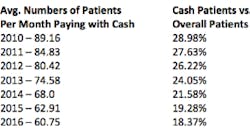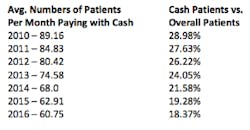Dental hygiene's net production: Was nosedive due to ignoring consumers' payment preferences?
By Kevin Henry
An interesting trend has formed around the dental hygiene department of the dental practice over the last six years. Using data collected from more than 10,000 dental practices around the country, Sikka Software has analyzed where hygienist net production per hour is today and where it’s been since 2010.
Over the last seven years, the average dental hygiene net production per hour has dropped from $77.40 in 2010 to $63.61 in 2016. Take a look at the roller coaster that has been the last seven years.
Hygienist Net Production Per Hour
- 2010—$77.40
- 2011—$70.14
- 2012—$58.58
- 2013—$62.14
- 2014—$62.27
- 2015—$61.32
- 2016—$63.61
While net production per hour in the dental hygiene department has climbed a bit since bottoming out in 2012, it’s still nowhere near its peak since the start of Sikka’s data collection.
So why has this taken such a nosedive? Part of the reason could be that more patients are now using insurance to pay for their treatment than paying straight cash. Take a look at some of the numbers we recently discovered, again using Sikka Software data.
When patients are relying on insurance more for their payments than what they might pay for out of pocket, they might be less likely to accept additional treatment. You’ve heard it often I’m sure: “If it’s not covered, I don’t want it.”
It can also be a matter of crunched scheduling. While it may seem logical that more patients per day would equal more revenue and production, the fact may be that patients begin to feel more like they’re at an assembly line than in an environment where people care about their health.
This quote from an earlier article in Dental Economics makes a compelling argument:
This extra attention leads to enhanced educational opportunities, more effective relationship building, fewer failed or cancelled recare appointments, a greater increase in case acceptance, plus an augmented number and quality of referrals. ("At my dentist's office, they take their time. I never feel rushed, and they always answer all my questions!")
So how are the numbers looking in your practice? Is your net production per hour on par with the numbers above, or are you beating them? Make sure you know what your numbers are. It might provide a great opportunity to talk within the practice about your practice’s dental hygiene model and any changes that could possibly need to be made. They could be changes that greatly benefit your patients.
My wife is a practice management consultant and one of her favorite quotes is, “Numbers tell a story.” What story are your production numbers telling?
An advocate of today’s dental assistant, Kevin Henry speaks to dental audiences across the nation on topics that empower dental assistants, helping them recognize the leadership role they hold in the practice. He is the co-founder of IgniteDA.net, a community designed to enlighten, empower, and educate dental assistants.







